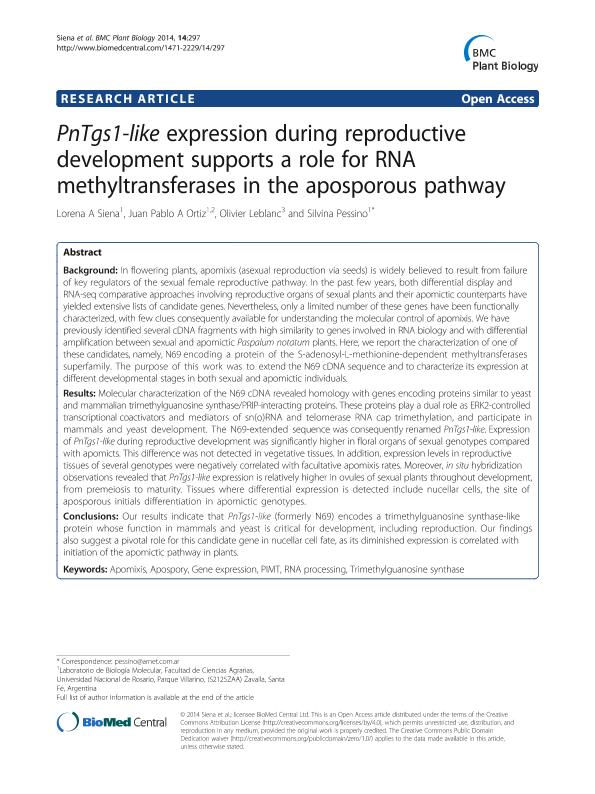Mostrar el registro sencillo del ítem
dc.contributor.author
Siena, Lorena Adelina

dc.contributor.author
Ortiz, Juan Pablo Amelio

dc.contributor.author
Leblanc, Olivier
dc.contributor.author
Pessino, Silvina Claudia

dc.date.available
2016-01-06T14:55:03Z
dc.date.issued
2014-11-18
dc.identifier.citation
Siena, Lorena Adelina; Ortiz, Juan Pablo Amelio; Leblanc, Olivier; Pessino, Silvina Claudia; PnTgs1-like expression during reproductive development supports a role for RNA methyltransferases in the aposporous pathway; BioMed Central; BMC Plant Biology; 14; 297; 18-11-2014; 1-10
dc.identifier.issn
1471-2229
dc.identifier.uri
http://hdl.handle.net/11336/3372
dc.description.abstract
Background: In flowering plants, apomixis (asexual reproduction via seeds) is widely believed to result from failure of key regulators of the sexual female reproductive pathway. In the past few years, both differential display and RNA-seq comparative approaches involving reproductive organs of sexual plants and their apomictic counterparts have yielded extensive lists of candidate genes. Nevertheless, only a limited number of these genes have been functionally characterized, with few clues consequently available for understanding the molecular control of apomixis. We have previously identified several cDNA fragments with high similarity to genes involved in RNA biology and with differential amplification between sexual and apomictic Paspalum notatum plants. Here, we report the characterization of one of these candidates, namely, N69 encoding a protein of the S-adenosyl-L-methionine-dependent methyltransferases superfamily. The purpose of this work was to extend the N69 cDNA sequence and to characterize its expression at different developmental stages in both sexual and apomictic individuals. Results: Molecular characterization of the N69 cDNA revealed homology with genes encoding proteins similar to yeast and mammalian trimethylguanosine synthase/PRIP-interacting proteins. These proteins play a dual role as ERK2-controlled transcriptional coactivators and mediators of sn(o)RNA and telomerase RNA cap trimethylation, and participate in mammals and yeast development. The N69-extended sequence was consequently renamed PnTgs1-like. Expression of PnTgs1-like during reproductive development was significantly higher in floral organs of sexual genotypes compared with apomicts. This difference was not detected in vegetative tissues. In addition, expression levels in reproductive tissues of several genotypes were negatively correlated with facultative apomixis rates. Moreover, in situ hybridization observations revealed that PnTgs1-like expression is relatively higher in ovules of sexual plants throughout development, from premeiosis to maturity. Tissues where differential expression is detected include nucellar cells, the site of aposporous initials differentiation in apomictic genotypes. Conclusions: Our results indicate that PnTgs1-like (formerly N69) encodes a trimethylguanosine synthase-like protein whose function in mammals and yeast is critical for development, including reproduction. Our findings also suggest a pivotal role for this candidate gene in nucellar cell fate, as its diminished expression is correlated with initiation of the apomictic pathway in plants.
dc.format
application/pdf
dc.language.iso
eng
dc.publisher
BioMed Central

dc.rights
info:eu-repo/semantics/openAccess
dc.rights.uri
https://creativecommons.org/licenses/by/2.5/ar/
dc.subject
Apomixis
dc.subject
Apospory
dc.subject
Gene Expression
dc.subject
Pimt
dc.subject.classification
Agronomía, reproducción y protección de plantas

dc.subject.classification
Agricultura, Silvicultura y Pesca

dc.subject.classification
CIENCIAS AGRÍCOLAS

dc.title
PnTgs1-like expression during reproductive development supports a role for RNA methyltransferases in the aposporous pathway
dc.type
info:eu-repo/semantics/article
dc.type
info:ar-repo/semantics/artículo
dc.type
info:eu-repo/semantics/publishedVersion
dc.date.updated
2016-03-30 10:35:44.97925-03
dc.journal.volume
14
dc.journal.number
297
dc.journal.pagination
1-10
dc.journal.pais
Reino Unido

dc.journal.ciudad
Londres
dc.description.fil
Fil: Siena, Lorena Adelina. Universidad Nacional de Rosario. Facultad de Ciencias Agrarias. Laboratorio de Biología Molecular; Argentina. Consejo Nacional de Investigaciones Científicas y Técnicas. Centro Cientifico Tecnológico Rosario; Argentina
dc.description.fil
Fil: Ortiz, Juan Pablo Amelio. Universidad Nacional de Rosario. Facultad de Ciencias Agrarias. Laboratorio de Biología Molecular; Argentina. Consejo Nacional de Investigaciones Científicas y Técnicas. Centro Científico Tecnológico Nordeste. Instituto de Botánica del Nordeste (i); Argentina
dc.description.fil
Fil: Leblanc, Olivier. Centre National de la Recherche Scientifique. Institut de Recherche pour le Developpement; Francia
dc.description.fil
Fil: Pessino, Silvina Claudia. Universidad Nacional de Rosario. Facultad de Ciencias Agrarias. Laboratorio de Biología Molecular; Argentina. Consejo Nacional de Investigaciones Científicas y Técnicas. Centro Cientifico Tecnológico Rosario; Argentina
dc.journal.title
BMC Plant Biology

dc.relation.alternativeid
info:eu-repo/semantics/altIdentifier/url/https://bmcplantbiol.biomedcentral.com/articles/10.1186/s12870-014-0297-0
dc.relation.alternativeid
info:eu-repo/semantics/altIdentifier/doi/http://dx.doi.org/DOI:10.1186/s12870-014-0297-0
Archivos asociados
